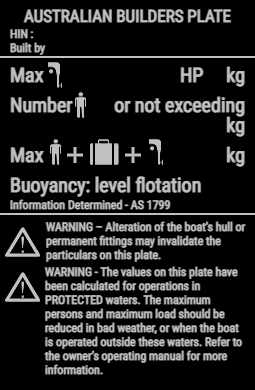Manufactured from anodised aluminium or #316 stainless steel our plates resist salt water,
outdoor exposure, abrasion, chipping and most industrial solvents and chemicals.
ABP Plates
Required on all recreational boats, with some limited exceptions, to provide safety
information
for the boat user or purchaser.
A new national standard for the ABP (edition 5) came into effect
in June 2021. Plates purchased from OnlineCompliancePlates have been updated to the latest
standard. For full details visit the Australian
Recreational Boating Safety Committee Website
The plate carries information regarding number of passengers and load limits, engine capacity
if
powered by an outboard motor, a buoyancy statement and the name of the standard used to
determine the information on the plate. Boats over 6 metres do not require a buoyancy
statement
Information contained on an Australian Builders Plate must be calculated by the builder,
importer or an competent person. A Naval Architect or Marine Surveyor can assist you in
calculating the information suitable for your boat.
Plates can be sequentially numbered for volume manufactuers or for bespoke importers and
manufactuers our ABP Plates Ondemand Service is ideally suited to
creating custom plates for each boat.
HIN Plates
Required as an international identification system on registerable boats.
The HIN is a 15 character unique number fixed in 2 locations to the boat, one on the transom
and
one in a hidden location known by the manufacturer / importer.

